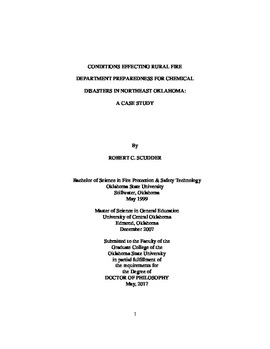| dc.contributor.advisor | Gill, Duane A. | |
| dc.contributor.author | Scudder, Robert Charles | |
| dc.date.accessioned | 2018-04-23T19:36:08Z | |
| dc.date.available | 2018-04-23T19:36:08Z | |
| dc.date.issued | 2017-05 | |
| dc.identifier.uri | https://hdl.handle.net/11244/299544 | |
| dc.description.abstract | Throughout history, humankind has struggled with vulnerability and the effects of disasters on the ill prepared. The community and field of disaster research acknowledges fire departments as key stakeholders in preparedness. These agencies commonly conduct pre-fire planning, purchase specialized equipment, and train for a variety of responses. Fire departments operate with certain types of capital, including funding, available personnel, community values and beliefs, political atmospheres, and natural and built environments; which limit or allow preparedness planning. Research has shown that, compared to their urban counterparts, rural communities have fewer trained and prepared personnel, less equipment, and a lack of financial capital with which to prepare for disaster events involving chemicals. Chemical use continues to increase in industry, and recent U.S. legislation has caused shipments through rural communities to escalate, resulting in an increased risk of chemical releases. Fire chiefs understand how the community creates and changes capital used by the fire department. This study examined the impact of community capitals on chemical disaster preparedness in rural Northeast Oklahoma fire departments from the fire chief perspective. | |
| dc.description.abstract | The 27 survey participants, and 21 interviewees, revealed that the social capital within the study region was robust. Strong community linkages created support for their local fire department. Although this support did not necessarily result in volunteers, it did result in reduced resistance to preparedness activities. Emergent themes revealed vulnerability in the meager number of capable and available personnel, lack of response equipment and materials, low perceived chemical risk, inadequate time, and inadequate consistent funding to prepare for chemical hazards. While community capitals in rural communities appear lacking, fire departments have found means of coping, allowing them to conduct some preparedness activities; but not for chemical disasters events. | |
| dc.format | application/pdf | |
| dc.language | en_US | |
| dc.rights | Copyright is held by the author who has granted the Oklahoma State University Library the non-exclusive right to share this material in its institutional repository. Contact Digital Library Services at lib-dls@okstate.edu or 405-744-9161 for the permission policy on the use, reproduction or distribution of this material. | |
| dc.title | Conditions effecting rural fire department preparedness for chemical disasters in Northeast Oklahoma: A case study | |
| dc.contributor.committeeMember | Greer, Alex | |
| dc.contributor.committeeMember | Whitham, Monica M. | |
| dc.contributor.committeeMember | Wang, Qingsheng | |
| osu.filename | Scudder_okstate_0664D_15167.pdf | |
| osu.accesstype | Open Access | |
| dc.type.genre | Dissertation | |
| dc.type.material | Text | |
| thesis.degree.discipline | Environmental Science | |
| thesis.degree.grantor | Oklahoma State University | |
